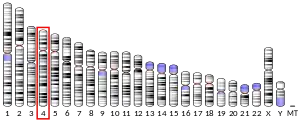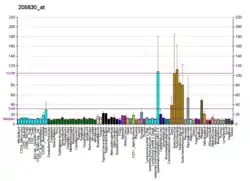Calmegin
Calmegin, also known as CLGN, is a protein which in humans is encoded by the CLGN gene.[5] Calmegin is also present in other animals including mice.[6]
| CLGN | |||||||||||||||||||||||||||||||||||||||||||||||||||
|---|---|---|---|---|---|---|---|---|---|---|---|---|---|---|---|---|---|---|---|---|---|---|---|---|---|---|---|---|---|---|---|---|---|---|---|---|---|---|---|---|---|---|---|---|---|---|---|---|---|---|---|
| Identifiers | |||||||||||||||||||||||||||||||||||||||||||||||||||
| Aliases | CLGN, calmegin | ||||||||||||||||||||||||||||||||||||||||||||||||||
| External IDs | OMIM: 601858 MGI: 107472 HomoloGene: 68392 GeneCards: CLGN | ||||||||||||||||||||||||||||||||||||||||||||||||||
| |||||||||||||||||||||||||||||||||||||||||||||||||||
| |||||||||||||||||||||||||||||||||||||||||||||||||||
| |||||||||||||||||||||||||||||||||||||||||||||||||||
| |||||||||||||||||||||||||||||||||||||||||||||||||||
| |||||||||||||||||||||||||||||||||||||||||||||||||||
| Wikidata | |||||||||||||||||||||||||||||||||||||||||||||||||||
| |||||||||||||||||||||||||||||||||||||||||||||||||||
Function
Calmegin is a testis-specific endoplasmic reticulum chaperone protein. CLGN may play a role in spermatogeneisis and infertility.[5]
References
- GRCh38: Ensembl release 89: ENSG00000153132 - Ensembl, May 2017
- GRCm38: Ensembl release 89: ENSMUSG00000002190 - Ensembl, May 2017
- "Human PubMed Reference:". National Center for Biotechnology Information, U.S. National Library of Medicine.
- "Mouse PubMed Reference:". National Center for Biotechnology Information, U.S. National Library of Medicine.
- "Entrez Gene: CLGN calmegin".
- Watanabe D, Yamada K, Nishina Y, Tajima Y, Koshimizu U, Nagata A, Nishimune Y (March 1994). "Molecular cloning of a novel Ca(2+)-binding protein (calmegin) specifically expressed during male meiotic germ cell development". J. Biol. Chem. 269 (10): 7744–7749. doi:10.1016/S0021-9258(17)37349-0. PMID 8126001.
Further reading
- Watanabe D, Yamada K, Nishina Y, et al. (1994). "Molecular cloning of a novel Ca(2+)-binding protein (calmegin) specifically expressed during male meiotic germ cell development". J. Biol. Chem. 269 (10): 7744–7749. doi:10.1016/S0021-9258(17)37349-0. PMID 8126001.
- Ikawa M, Wada I, Kominami K, et al. (1997). "The putative chaperone calmegin is required for sperm fertility". Nature. 387 (6633): 607–611. Bibcode:1997Natur.387..607I. doi:10.1038/42484. PMID 9177349. S2CID 4347203.
- Tanaka H, Ikawa M, Tsuchida J, et al. (1998). "Cloning and characterization of the human Calmegin gene encoding putative testis-specific chaperone". Gene. 204 (1–2): 159–163. doi:10.1016/S0378-1119(97)00537-4. PMID 9434179.
- Yoshinaga K, Tanii I, Toshimori K (1999). "Molecular chaperone calmegin localization to the endoplasmic reticulum of meiotic and post-meiotic germ cells in the mouse testis". Arch. Histol. Cytol. 62 (3): 283–293. doi:10.1679/aohc.62.283. PMID 10495883.
- Ikawa M, Nakanishi T, Yamada S, et al. (2002). "Calmegin is required for fertilin alpha/beta heterodimerization and sperm fertility". Dev. Biol. 240 (1): 254–261. doi:10.1006/dbio.2001.0462. PMID 11784061.
- Strausberg RL, Feingold EA, Grouse LH, et al. (2003). "Generation and initial analysis of more than 15,000 full-length human and mouse cDNA sequences". Proc. Natl. Acad. Sci. U.S.A. 99 (26): 16899–16903. Bibcode:2002PNAS...9916899M. doi:10.1073/pnas.242603899. PMC 139241. PMID 12477932.
- Ota T, Suzuki Y, Nishikawa T, et al. (2004). "Complete sequencing and characterization of 21,243 full-length human cDNAs". Nat. Genet. 36 (1): 40–45. doi:10.1038/ng1285. PMID 14702039.
- Gerhard DS, Wagner L, Feingold EA, et al. (2004). "The status, quality, and expansion of the NIH full-length cDNA project: the Mammalian Gene Collection (MGC)". Genome Res. 14 (10B): 2121–2127. doi:10.1101/gr.2596504. PMC 528928. PMID 15489334.
- Rual JF, Venkatesan K, Hao T, et al. (2005). "Towards a proteome-scale map of the human protein-protein interaction network". Nature. 437 (7062): 1173–1178. Bibcode:2005Natur.437.1173R. doi:10.1038/nature04209. PMID 16189514. S2CID 4427026.
- Kim DH, Shim JS, Kwon HJ (2005). "Coordinated transcriptional regulation of calmegin,a testis-specific molecular chaperon, by histone deacetylase and CpG methyltransferase". Experimental & Molecular Medicine. 37 (5): 492–496. doi:10.1038/emm.2005.61. PMID 16264275.
- Olsen JV, Blagoev B, Gnad F, et al. (2006). "Global, in vivo, and site-specific phosphorylation dynamics in signaling networks". Cell. 127 (3): 635–648. doi:10.1016/j.cell.2006.09.026. PMID 17081983. S2CID 7827573.
This article is issued from Wikipedia. The text is licensed under Creative Commons - Attribution - Sharealike. Additional terms may apply for the media files.




